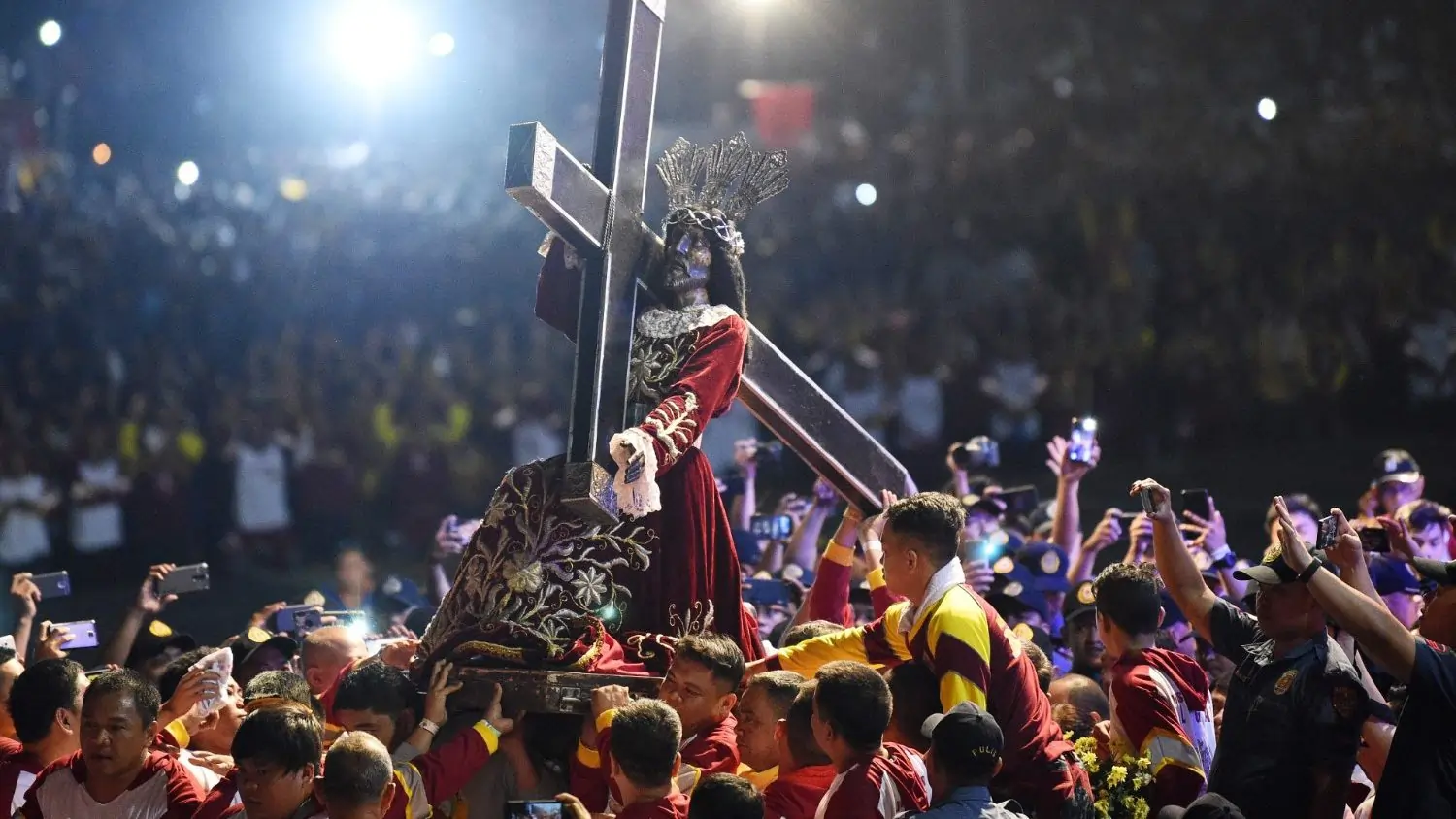The Black Nazarene Phenomenon:
The Black Nazarene Phenomenon Situated in the center of Quiapo, Manila, the The Black Nazarene Phenomenon is an enduring emblem of faith and devotion in the Philippines.
This highly respected religious icon, which is carved from dark wood and depicts Jesus Christ carrying the cross, is melancholy in color, a witness to the deep respect it is held in.
Its presence is entwined with a web of healings and prayers answered, encouraging followers to believe unwaveringly in its supernatural abilities.
The Feast of the The Black Nazarene Phenomenon culminates on January 9, a day of intense devotion and adoration. Thousands of worshippers travel from all across the archipelago to Quiapo for this yearly festival, which honors this hallowed picture.
A passionate buzz electrifies the air as the first light appears on the horizon, the streets filled with a wave of followers dressed in maroon, a vivid display of their unwavering commitment.
Amid this intense build-up, the Black Nazarene icon appears, lifted atop a carriage, signaling the start of the procession.
A current of energy flows through the throng of worshippers, a swaying tide of people driven by a constant desire to be up close and personal with the holy statue. Their combined ardor permeates the atmosphere, a tangible energy propelling every stride ahead.
Devotees of the Black Nazarene Phenomenon advance toward the holy symbol with their arms out and their hearts full of prayers, propelled by an unwavering desire to touch it in order to receive blessings, comfort, and divine intervention.
Every outstretched hand and every voice raised in prayer is a reflection of the enduring faith that binds them together on this journey of devotion.
In the tumultuous cacophony of adoration, there’s a deep peace—an unspoken mutual understanding that cuts through the throng.
A tribute to the continuing power of belief and the pursuit of spiritual connection, it is a communion of souls bound by a common faith, with each heart beating in time with the collective hope sewn into the fabric of this hallowed procession.
The grandeur of the Traslación reaches beyond the bounds of religious practice and becomes a communal experience that captures the essence of spirituality and oneness among Filipinos.
Enmeshing hearts and minds in a common journey towards spiritual connectedness, there is a widespread trust in the transformational power of faith amid the hustle and bustle of the streets.
The Feast of the Black Nazarene Phenomenon is more than just a party; it’s a powerful proclamation of faith, a symbol of solidarity, and a celebration of the unbreakable spirit of the followers who gather in Quiapo’s streets.
It’s a symphony with a chorus of unwavering belief made up of varied voices harmonizing.
This yearly Black Nazarene Phenomenon procession is more than simply a custom; it’s a holy dance of devotion, an illustration of the faith’s unwavering strength, and a celebration of the solidarity that unites a country in mutual respect.
It acts as a moving reminder of the transformational potential of faith and the deep influence of group spirituality on the human condition.
Millions of people watch the Traslación, a spectacle that transcends religious practice and speaks to the core of Filipino togetherness and spirituality.
Even in the middle of the madness, in the middle of the busy streets, there is an unspoken agreement—a mutual belief in the powerful impact of religion.
It is more than just a traditional ceremony; it represents an unspoken oath, a spiritual connection between the heavenly and the holy.
Held aloft amidst the roaring crowd, the Black Nazarene Phenomenon represents a channel for hopes, healing, and a close relationship with God.
This is a monument to unification, to the steadfast faith and resiliency of the Filipino character, and it transcends religious ties. Distinctions become a common journey of belief in this confluence.
Not only is the Feast of the Black Nazarene Phenomenon a joyous occasion, but it’s also a moving affirmation of one’s faith, a celebration of solidarity, and a memorial to the unwavering devotion of the followers gathered in Quiapo’s streets.
It’s a carefully composed symphony of diverse voices harmonizing into a continuous chorus of unwavering conviction.
There is a strong sense of unanimity—a bond that transcends the material world—amid the throng of people and the busy streets. In their quest for blessings and spiritual fulfillment, devotees discover that they are bound together by an unseen bond of faith.
It’s the instant when personal ambitions combine to become a common desire for heavenly favor.
There is an unexplainable beauty in this coming together of hearts and dreams—a silent recognition that every soul in attendance is a part of the group’s devotion and spiritual quest.
Seeking blessings and miracles is not the only goal; it’s a journey of the spirit that unites us all, a sacred entwining that surpasses the chaotic events taking place in the material world.
Among the fervor and fervent prayers, there’s a quiet understanding—a recognition that in this moment, amidst the clamor and the crowded streets, a profound communion of hearts takes place—a spiritual connection that speaks volumes without the need for words.
The Black Nazarene Phenomenon experience:
Witnessing the Black Nazarene Phenomenon is an experience that goes beyond simple observation and is incredibly spiritual and absorbing. It’s a profound trip into the core of Filipino faith, where enthusiasm, dedication, and a feeling of belonging come together.
Joining the march entails joining a great ocean of people who are all united by the desire to honor, adore, and ask for blessings from the venerated Black Nazarene.
There is a tangible energy to the place; hymns are sung, prayers are muttered, and the feelings are strong and unfiltered.
The physical requirements are high. This difficult but incredibly significant experience is made possible by the overwhelming number of individuals pushing ahead, the struggle against the crowd’s momentum, and the persistent presence of barriers.
The common adversity creates a strong sense of connection among followers through companionship and solidarity.
There’s a calm reverence in the middle of the pandemonium. Acts of devotion are how devotees demonstrate their faith: some walk barefoot, some hold up saintly images, and many ardently recite prayers.
These are all expressions of their unshakable confidence in the intervention of the Black Nazarene Phenomenon. The variety of individual trips inside this communal trek is what’s so amazing. Every follower comes to the Black Nazarene with their own prayers, dreams, and hopes in hopes of receiving comfort or miracles.
People have a very personal spiritual encounter when they receive direction, strength, or healing, which strengthens their belief in the Black Nazarene’s miraculous abilities.
In the end, seeing the Black Nazarene Phenomenon is more than just seeing a religious event; it’s an immersing exploration of the Filipino soul, a monument to steadfast faith, group unity, and the search for heavenly connection amid a shared spiritual embrace.
Beyond just a religious figure, followers of the Black Nazarene Phenomenon see him as a symbol of healing, optimism, and steadfast fortitude. Its significance goes beyond simple adoration and has developed into a potent emblem of the relationship between faith and human existence.
Numerous stories of answered prayers and miraculous interventions that resound through the ages are interwoven with the Black Nazarene Phenomenon story. These stories, handed down through the ages, strengthen the notion of its ethereal abilities.
These tales provide comfort and encouragement to devotees, who see the Black Nazarene as a channel for heavenly favor and healing miracles.
Moreover, this annual spectacle is a cultural cornerstone, engrained in the collective consciousness of the Filipino people. It celebrates not only religious fervor but also the shared values of solidarity and community spirit.
The Black Nazarene phenomenon is, at its core, a profound representation of the Filipino spirit—a symbol of unwavering pursuit for divine favor, unity amidst difference, and enduring faith.
Its importance transcends religious rites and resonates profoundly in the hearts of people who engage in it, creating a lasting impression on society and acting as a source of spiritual strength for future generations.








